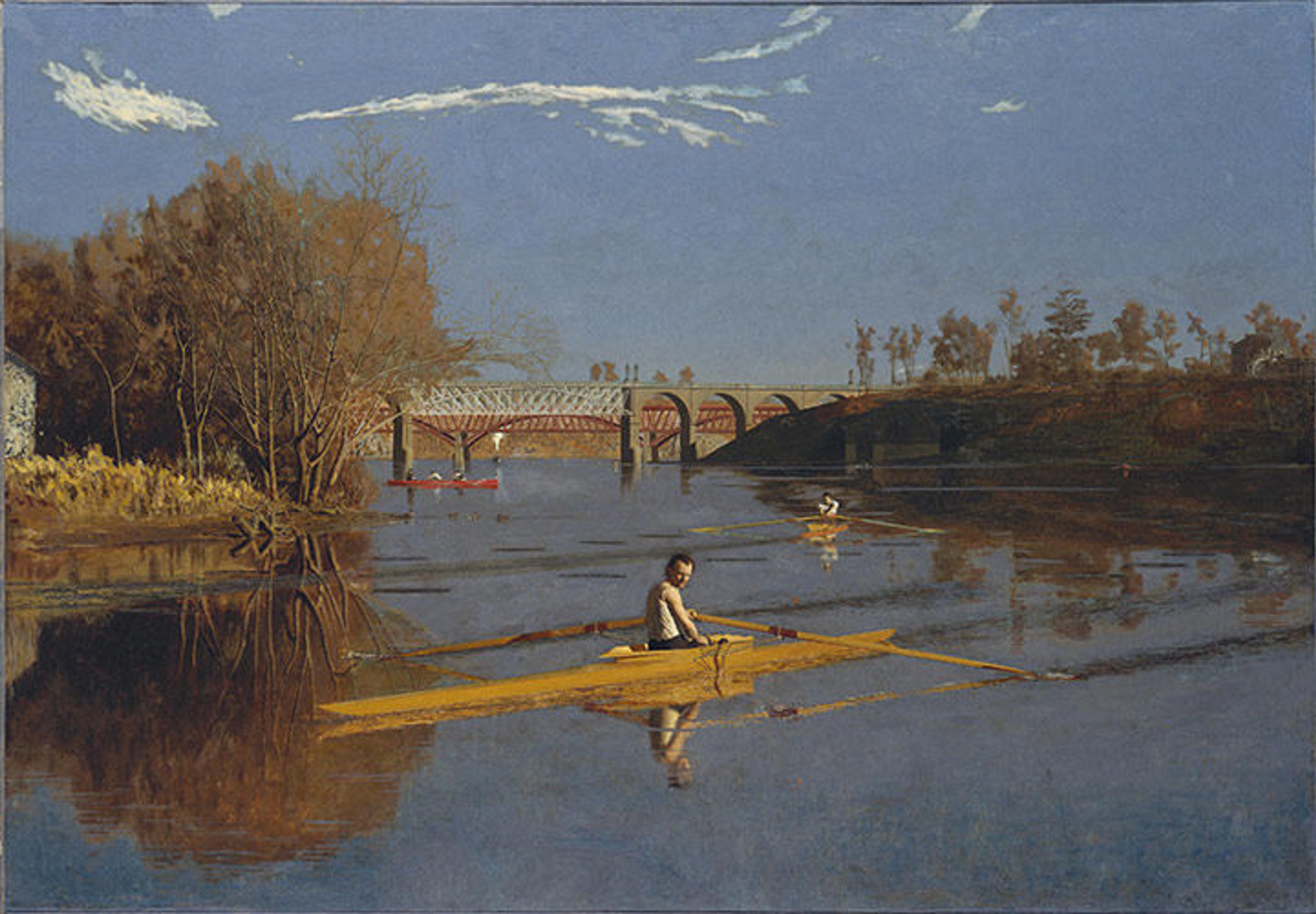
Thomas Eakins (American, 1844–1916). The Champion Single Sculls (Max Schmitt in a Single Scull), 1871. Oil on canvas, 32 1/4 x 46 1/4 in. (81.9 x 117.5 cm). The Metropolitan Museum of Art, New York. Purchase, The Alfred N. Punnett Endowment Fund and George D. Pratt Gift, 1934 (34.92)
«If sports inspire and engage you—as a participant or as an observer—then you already know the important role they've played throughout history. But did you know that depictions of athletes and athletic endeavors from over two millennia around the world can be found in many galleries at The Met? Here are just 10 of the sports-inspired artworks and objects in the Museum. Although this post is intended as an armchair guide, the objects are organized according to their location in the galleries, in case you want to use them as an actual itinerary during your next visit.»
(Note that the works on paper are sensitive to light and can only remain on view for a limited time. Be sure to check their location prior to your visit.)
Stop 1: Galleries 153 and 154 (Greek and Roman Art)
Sport: Running and Training in Ancient Greece
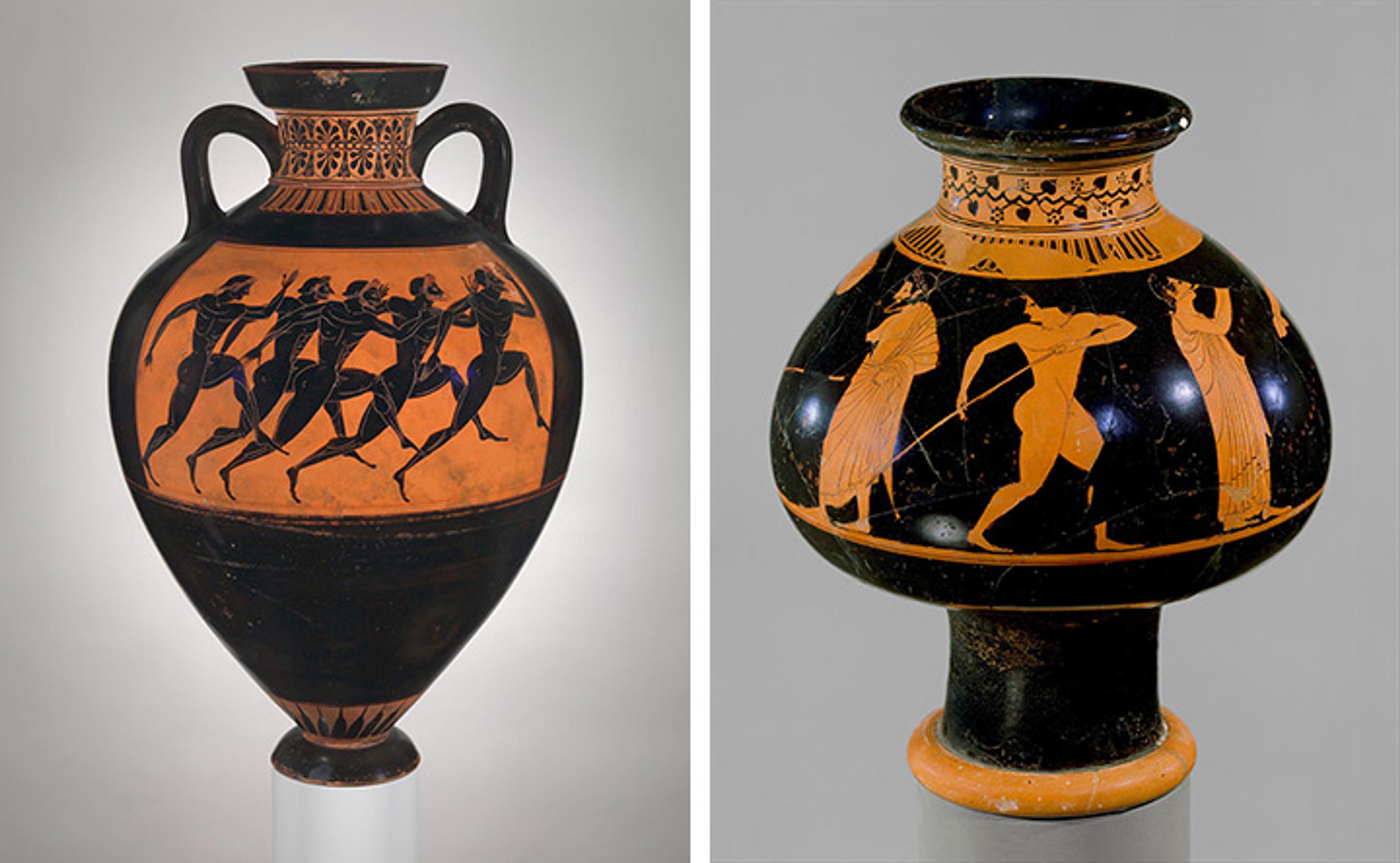
Left: Terracotta Panathenaic prize amphora. Attributed to the Euphiletos Painter. Archaic period, ca. 530 B.C. Greek, Attic. Terracotta; black-figure. The Metropolitan Museum of Art, New York, Rogers Fund, 1914 (14.130.12). Right: Terracotta psykter (vase for cooling wine). Attributed to Oltos. Archaic period, ca. 520–510 B.C. Greek, Attic. Terracotta; red-figure. The Metropolitan Museum of Art, New York, Rogers Fund, 1910 (10.210.18)
The ancient Greeks esteemed the human body as the most beautiful of forms and tried to make their own bodies perfect through exercise. Games were held throughout Greece, and the victors were celebrated in verse, by honorific statues, and with prizes. The games also served an essential role in training warriors for battle in the frequent wars between the Greek city states. The vessel on the left, which has an image of runners, was given as a prize at the Panathenaic games about 2,500 years ago. On the vessel at right are images of athletes practicing in a gymnasium: a discus thrower, broad jumper, javelin thrower, two trainers, and a judge.
Stop 2: Gallery 358 (Arts of Africa, Oceania, and the Americas)
Sport: Ball Games in Mesoamerica

Left: Seated ballplayer, 1st century B.C.–A.D. 3rd century. Mexico, Mesoamerica. Ceramic. The Metropolitan Museum of Art, New York, Gift of The Andrall and Joanne Pearson Collection, 2005 (2005.91.1). Right: Standing ballplayer, 1st century B.C.–A.D. 3rd century. Mexico, Mesoamerica. Ceramic. The Metropolitan Museum of Art, New York, Gift of The Andrall and Joanne Pearson Collection, 2005 (2005.91.13)
Long before the Spaniards arrived in the New World, people were playing ball throughout ancient Mesoamerica: more than 1,500 ancient ball courts have been discovered. Although the game and its rules varied by location, the common element was (you guessed it) a rubber ball. Rubber is native to the area.
Stop 3: Gallery 352 (Arts of Africa, Oceania, and the Americas)
Sport: Masked Race on the Ivory Coast
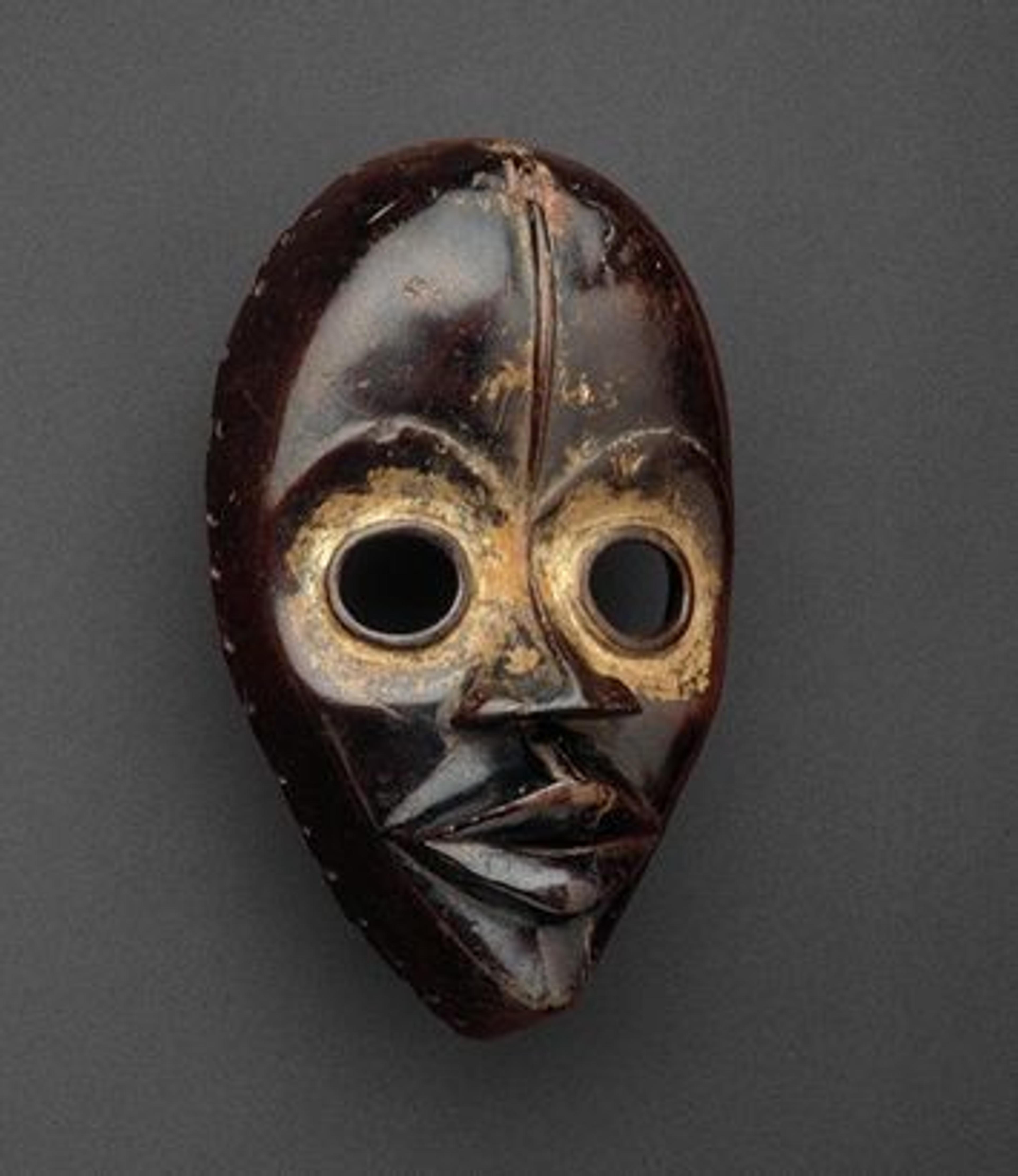
In Dan communities of western Côte d'Ivoire, dangerous immaterial forest spirits are translated into the forms of human face masks. One of the dozen artistic personalities embodied in such masks is Gunye Ge, whose mask is worn by a community's champion foot racer in competitions. During weekly races in the dry season, a runner wearing such a mask chases an unmasked runner. If he manages to catch him, he keeps his mask. If not, the unmasked runner puts on his own mask and chases another competitor in turn. At the end of the season, the runner with the most victories is declared the champion.
A Yakouba carver. Face mask (Gunye Ge), 19th–20th century. Côte d'Ivoire, Trokpadrou village. Dan peoples. Wood, pigment, kaolin. The Metropolitan Museum of Art, New York, Gift of Lilliam and Sidney Lichter, 1985 (1985.420.2)
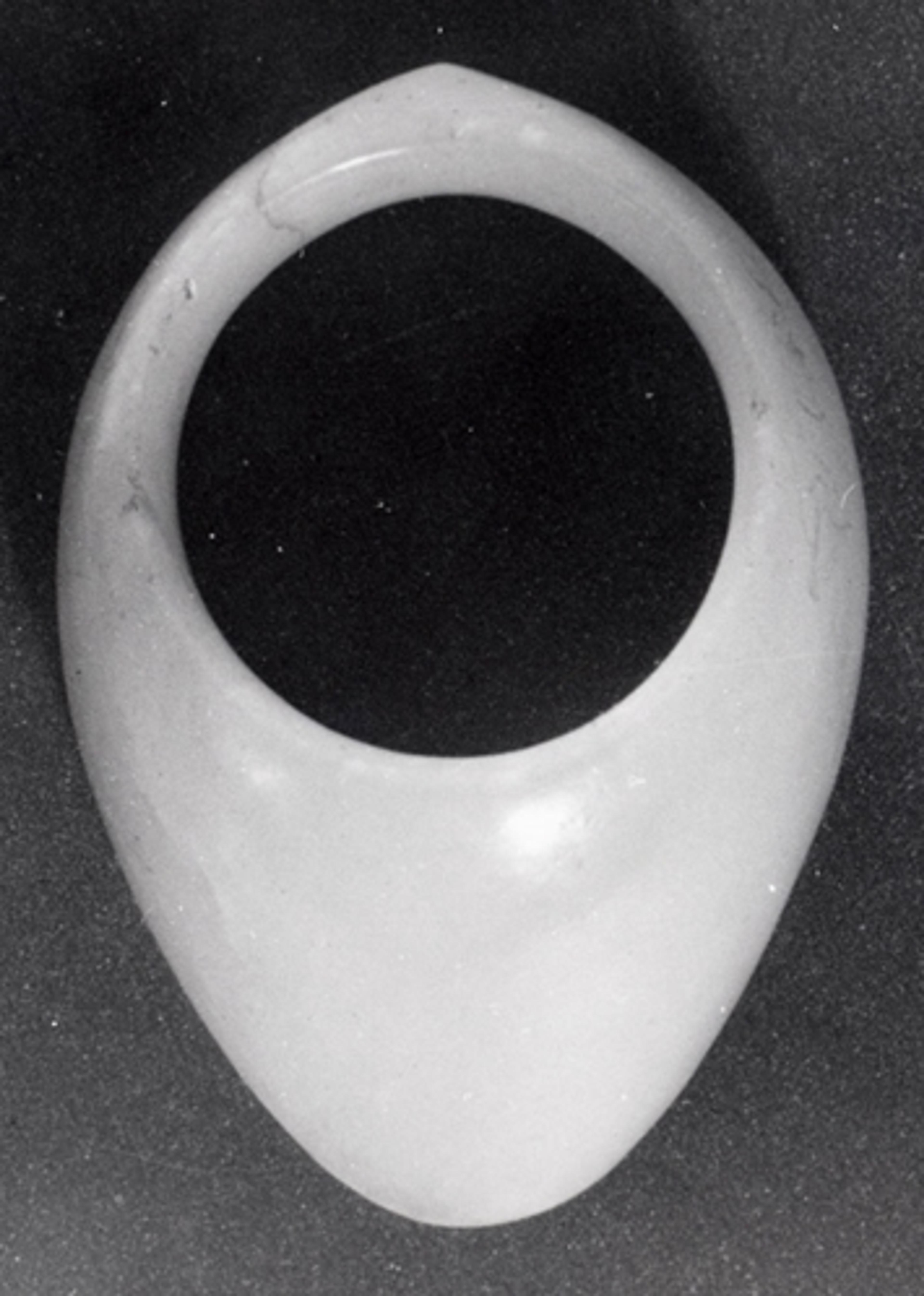
Stop 4: Gallery 463 (Islamic Art)
Sport: Archery in India
Archers in many parts of the world wore an archer's ring to protect their thumb when they released the bowstring. Different shapes are traditional in different regions. The simple form of this Mughal archer's ring suggests that it was intended to be functional, rather than decorative. The use of nephrite (jade) indicates the wealth and status of its owner.
Archer's ring, 17th century. India. Nephrite. The Metropolitan Museum of Art, New York, Rogers Fund, 1952 (52.119.6)
Stop 5: Gallery 462 (Islamic Art)
Sport: Polo in Persia
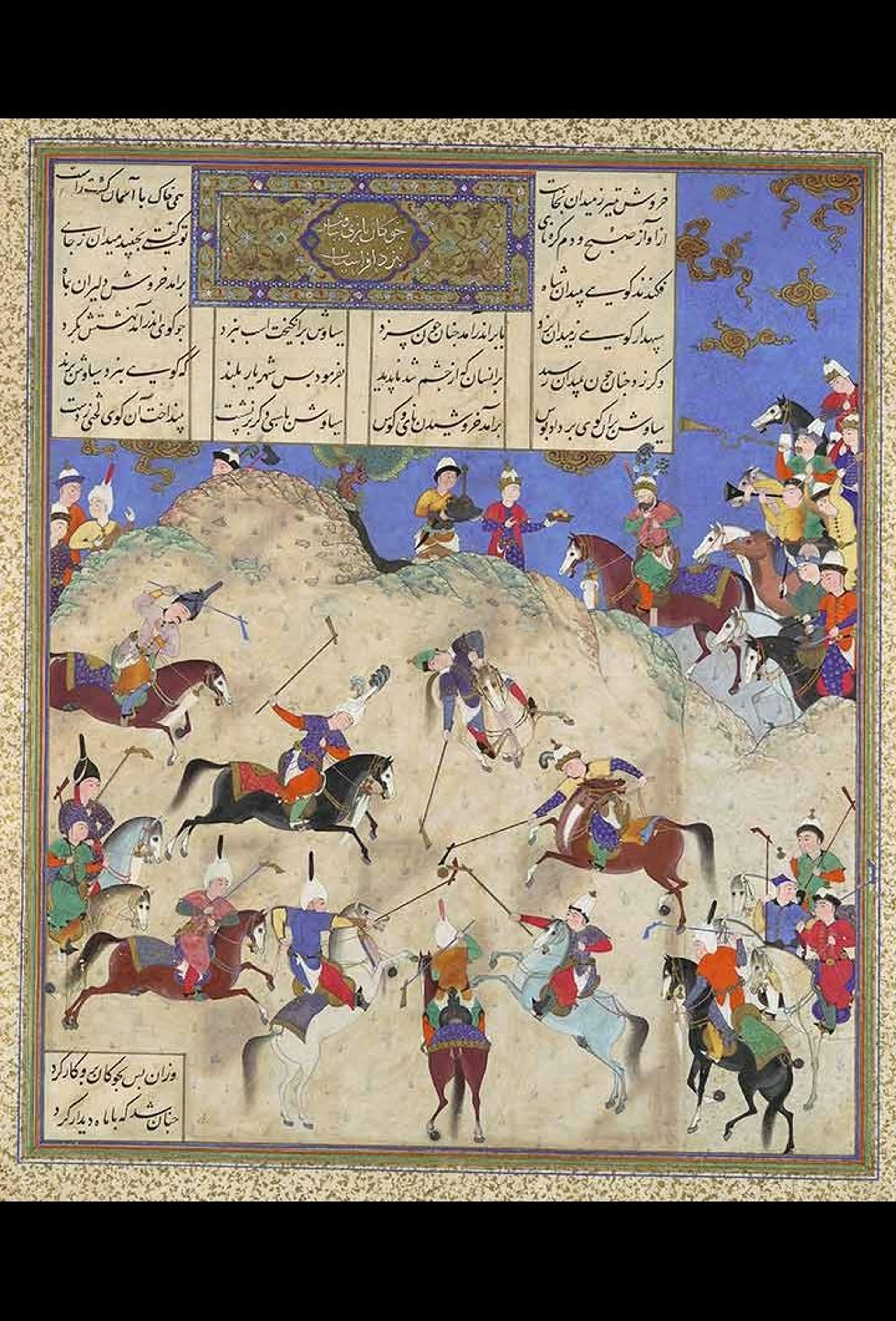
"Siyavush Plays Polo before Afrasiyab," Folio 180v from the Shahnama (Book of Kings) of Shah Tahmasp, ca. 1525–30. Text composed by Abu'l Qasim Firdausi (935–1020); painting attributed to Qasim ibn 'Ali (active ca. 1525–60). Iran, Tabriz. Opaque watercolor, ink, silver, and gold on paper. The Metropolitan Museum of Art, New York, Gift of Arthur A. Houghton, Jr., 1970 (1970.301.26)
Originating in ancient Persia at least 2,000 years ago and still played today, polo is often called the sport of kings. In this painting from the Shahnama (Book of Kings), the legendary prince Siyavush rides a black horse in the center of the field, while king Afrasiyab observes from his own horse on the horizon at upper right. Behind him, two men play the horn.
Stop 6: Gallery 306 (Medieval Art)
Sport: Jousting in the Middle Ages

Plaque from a casket with jousting scenes, ca. 1320–40. French. Ivory. The Metropolitan Museum of Art, New York, Gift of J. Pierpont Morgan, 1917 (17.190.256)
The medieval joust—a tournament in which armed opponents displayed their bravery and skill to onlookers—arose from the military use of weapons by heavy cavalry in battle. This tiny ivory plaque (just three inches tall!) features all of the elements of a joust. In the center, knights on horseback attempt to unseat one another using lances. Spectators observe from a safe distance, and two trumpeters sitting in the trees provide the fanfare.
Stop 7: Gallery 376 (Arms and Armor)
Sport: Fencing in Europe
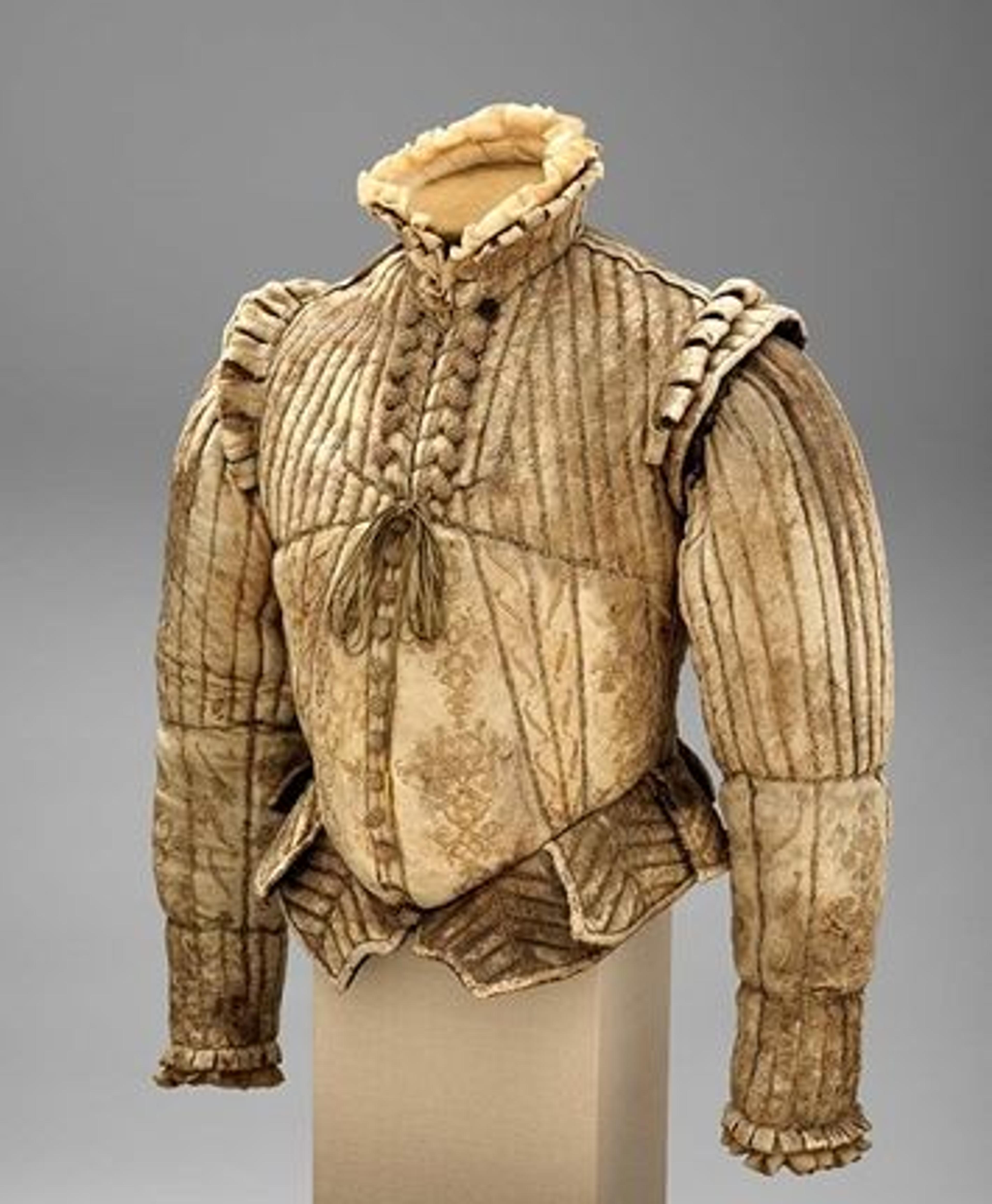
The sport of fencing developed from the techniques and tactics of swordsmanship used for self-defense. At one time, fencing was part of every gentleman's education. The type of doublet shown here was fashionable in Western Europe around 1580, and the use of leather and padding throughout suggests that it was worn in fencing practice.
Fencing doublet, ca. 1580. Western Europe. Leather, silk, linen, cotton. The Metropolitan Museum of Art, New York, Bashford Dean Memorial Collection, Funds from various donors, 1929 (29.158.175)
Stop 8: Gallery 680 (Musical Instruments)
Sport: The Sounds of Soccer
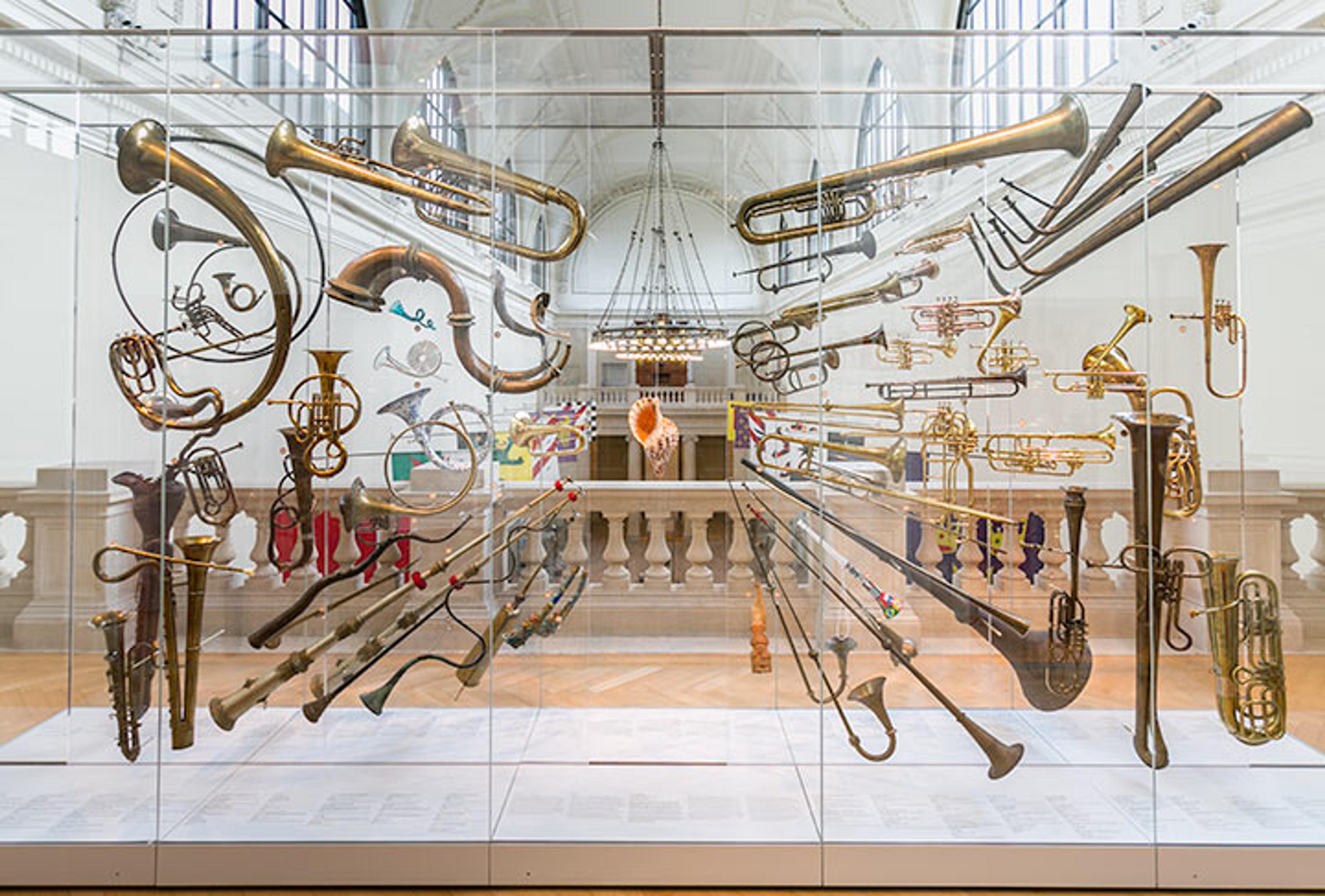
Vew of Fanfare, the signature display in gallery 680 at the main entrance to the galleries of the Department of Musical Instruments
The involvement of the crowd adds to the excitement of watching any sport. One of the horns on view in this signature display of musical instruments is a vuvuzela, a horn blown by fans at soccer matches. Particularly associated with South Africa, it is used all over Europe and South America as well. Can you find it?
Stop 9: Gallery 773 (American Wing)
Sport: Crazy for Baseball (and More)
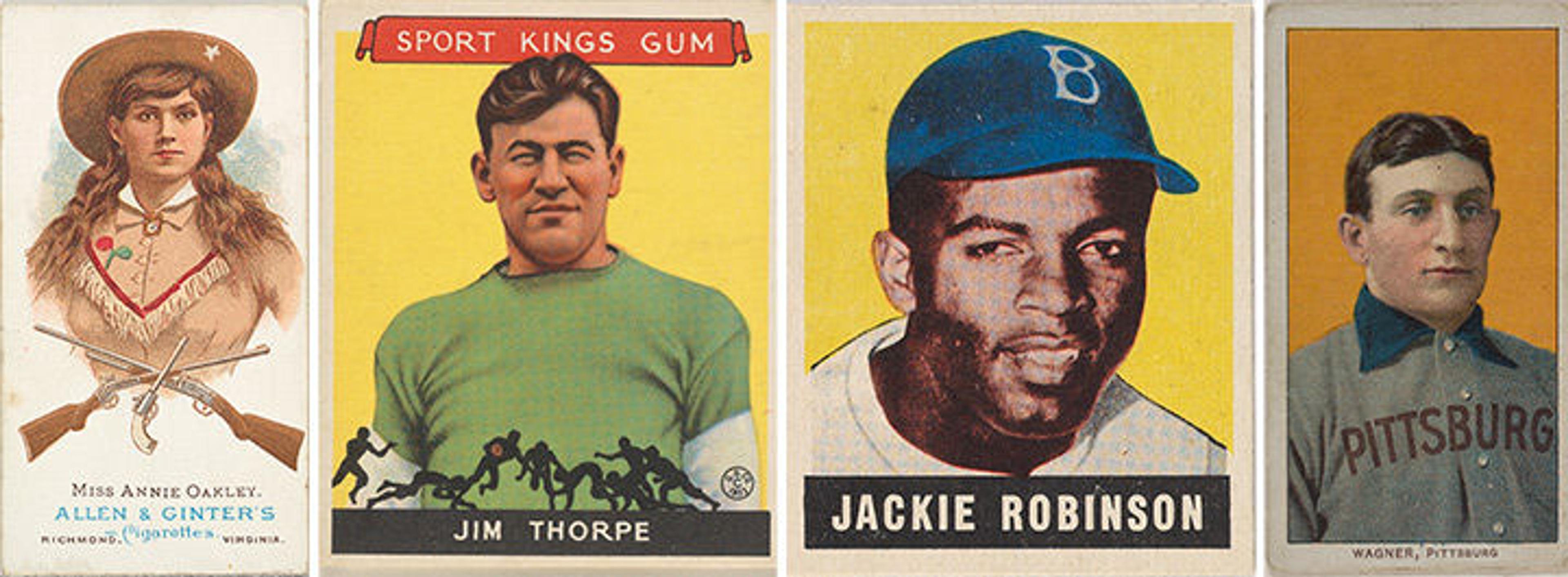
Far left: Miss Annie Oakley, Rifle Shooter, 1887. World's Champions, Series 1 (N28) for Allen & Ginter Cigarettes. Publisher: Allen & Ginter (American, Richmond, Virginia). Lithographer: Lindner, Eddy & Claus (American, New York). Commercial color lithograph. The Metropolitan Museum of Art, New York, The Jefferson R. Burdick Collection, Gift of Jefferson R. Burdick (63.350.201.28.41). Center left: Jim Thorpe, Football, 1933. Goudey Gum Company. Commercial lithograph. The Metropolitan Museum of Art, New York, The Metropolitan Museum of Art, New York, The Jefferson R. Burdick Collection, Gift of Jefferson R. Burdick (Burdick 326, R338.7). Center right: Jackie Robinson, Brooklyn Dodgers, 1948–49. Leaf Gum, Co., Chicago, Illinois. Commercial chromolithograph. The Metropolitan Museum of Art, New York, The Jefferson R. Burdick Collection, Gift of Jefferson R. Burdick (Burdick 326, R401–1.30). Far right: Honus Wagner, 1909–11. White Borders, American Tobacco Company Issue. The Metropolitan Museum of Art, New York, The Jefferson R. Burdick Collection, Gift of Jefferson R. Burdick (Burdick 246, T206)
Jefferson R. Burdick (1900–1963) donated more than 300,000 trade cards to The Met, including more than 30,000 baseball cards. The Jefferson R. Burdick Collection is one of the largest and most comprehensive collections of American trade cards ever assembled privately in the United States, but as far as can be determined, he himself never attended a baseball game! A selection of cards from this collection is always on view. The exhibition usually focuses on baseball, but past displays have also included such topics as female athletes, football, breaking the color barrier, and the dead-ball era. The display changes twice a year.
Stop 10: Online Exclusive
Sport: Sumo Wrestling in Japan
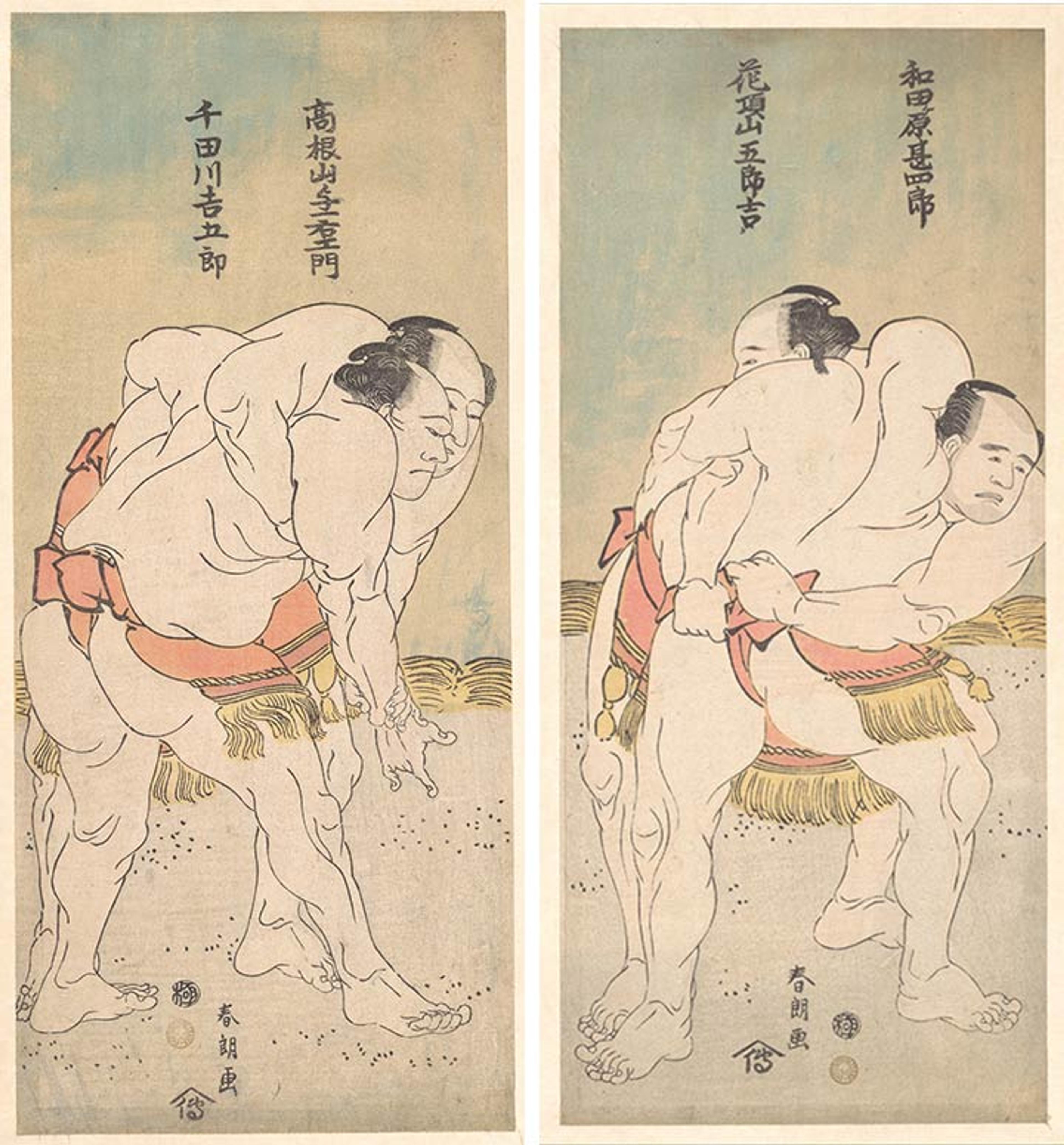
Left: Katsushika Hokusai (Japanese, 1760–1849). The sumo wrestlers Takaneyama Yoichiemon and Sendagawa Kichigorō, ca. 1783. Right: Katsushika Hokusai (Japanese, 1760–1849). The sumo wrestlers Wadagahara Jinshirō and Kachōzan Gorokichi, ca. 1783. Edo period (1615–1868). Japan. Polychrome woodblock print; ink and color on paper. The Metropolitan Museum of Art, New York, The Francis Lathrop Collection, Purchase, Frederick C. Hewitt Fund, 1911 (JP741 and JP742)
In Sumo wrestling, each wrestler attempts to force his opponent out of the ring or make him touch the ground with any part of his body other than the soles of his feet. The wrestlers in these woodblock prints are depicted in mid-action, trying to subdue and dislodge their opponents in order to win. These rare woodblock prints, created by the famous print artist Hokusai early in his career, are not on display at the moment; but if you click on the images, you will be able to zoom in and see them in great detail.
Did we miss your favorite sport? Let us know for another future "Met-athlon" post.
See our related Pinterest board.